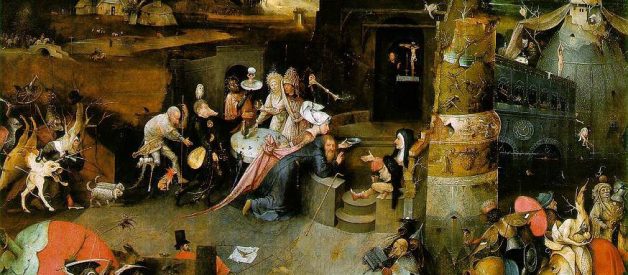An exhaustive study of two works.
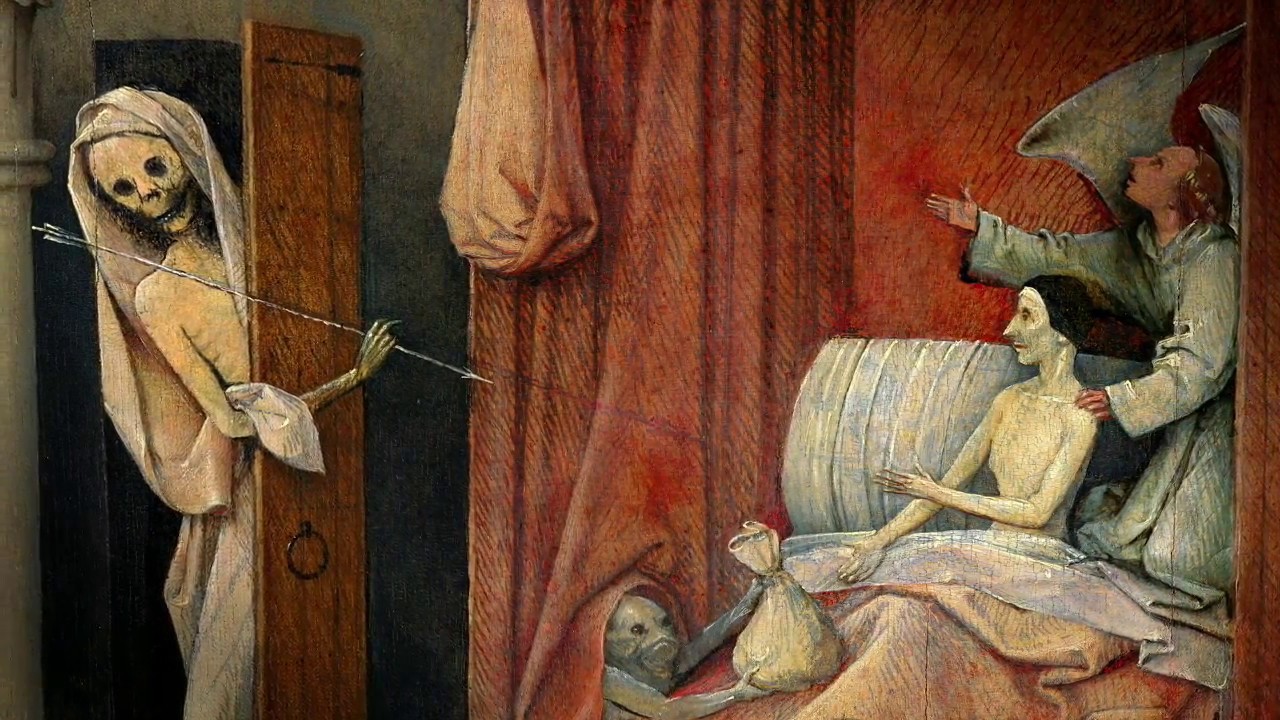 Bosch, ?Death and the Miser.? 1494?1516, oil on wood paneel. 3’0″ by 1’0″. National Gallery of Art.
Bosch, ?Death and the Miser.? 1494?1516, oil on wood paneel. 3’0″ by 1’0″. National Gallery of Art.
I. Introduction
Hieronymus Bosch has defied pretty much all art historical methods in the study of both his work and work done in his style. Bosch?s work is psychologically raw, yet psychology in and of itself cannot pin his work and its intended message down. Indeed, Bosch has often been called ?the first Surrealist?. One would be forgiven for viewing Bosch?s work for the first time and thinking it was created during the Surrealist Movement with the unconscious being splayed not just on canvas but in the public mind; guided in method by the great works of Sigmund Freud and Carl Jung. Dali had a great talent for showmanship and hobnobbing with many crowds to get his art into the world: a famous line of his being, ?I am Surrealism.? Bosch, however, was Surrealism more than 400 years before the greats of the movement like Salvador Dali and Rene Magritte were even born.
So, what is the best light, the understanding that is best employed, to view his work? Bosch?s work has been labeled ?demon making,? yet the folklore and religion of his time are not sufficient to pin down his work and its intended message. His work has been examined in light of alchemical and Rosicrucian traditions; yet these esoteric schools are not in and of themselves sufficient to really understand Bosch?s message. Bosch has been put through many schools of astrological thought (these traditions themselves are quite misunderstood by the modern art historian) with not much avail. Bosch and his work have also been repeatedly put through the historiographic thresher, with basically no product coming out. Bosch has been examined linguistically in light of motifs in his works that have been interpreted as Dutch proverbs in animalistic, hellish, and monstrous embodiments. Yet this alone also falls short of grasping Bosch?s message.
So, in this dizzying array of schools of thought, lenses through which to view the works, what is the best way to study and truly understand the message of the enigma that is Hieronymus Bosch? The best way is to combine the methods and schools of thought discussed above; all of the schools and points to be researched in depth. The psychological Bosch must be employed just as the historical, the alchemical, Rosicrucian, and possibly heretical Bosch. This is precisely what this study will attempt to do. In examining Bosch we must cast a wider net to truly understand his work and works done in his name by unnamed esoteric artists lost to the dust bin of history.
II. What Shaped Bosch?s Aesthetic
Not much is known about Bosch?s early life. His name was first mentioned in the city records of Aachen, Netherlands in 1474 but his birth has been dated to 1450 based on a portrait that could be a self-portrait that was painted in 1516: the year of his death. The painting shows the artist at an advanced age, most likely 60.
Bosch would?ve grown up around some very talented craftspeople in Europe. The Netherlands were basically the world?s center, at Bosch?s time, for very high quality glass fixtures. In the glass blowers? shops, Bosch would have seen many a bizarre organic form as the glass was being blown. This very likely had an influence on the more bizarre looking forms in his work. The soaring forms of gothic cathedrals, the woodcuts in their pews, and the multitude of horrifying forms that are embodied in the gothic gargoyle also likely contributed to the highly developed horrifying aesthetic that is Bosch?s body of work. This likely did much to spur the first written description of Bosch in 1560 by Felipe de Guevara of Spain, calling him ?the inventor of monsters and chimeras.?
It is also incumbent to remember that Europe was still very much in the trails of epidemics like the Black Plague. Europe had but a single lens to look at such vast tragedies: the Roman Catholic Church. Science simply was not around at this very bleak time in human history, and really would not make significant strides for over one hundred years from the presumed date of Bosch?s birth. Thus the Plague was seen as things like the ?punishment of sinful humanity? and through other Church dogmatic lenses. This did a lot to contribute to another social problem of the time: the witch burnings. Without an additional, objective lens through which to view historical tragedies like the Plague, people ultimately devolve into forms of scapegoating like witch hunts. The Inquisition and the ?Church Triumphant? were about at their respective peaks too. Yet, there was yet another storm brewing on the horizon for Europe in the form of the Reformation (and, of course, the Counter-Reformation) which saw its unofficial beginning only one year after Bosch?s death in 1516, with Martin Luther nailing his 95 Theses to the door of the church in Wittenberg, Germany. This was, of course, further compounded by abuses of power by a multitude of both church and secular authorities across Europe.
This was a perfect storm for Europe and indeed very fertile ground from with to both reap and sow literal and allegorical monsters from the popular psychological soil. Bosch did both of these in his body of work. In the process, he left the Western mind with an archetype of hell that still lurks in the collective unconscious: the scorched Earth, the fire and brimstone raining down, poor sinners being tormented by devils, and a whole multitude of monsters and generally ugly things. A great piece to begin this study of Bosch?s archetype of hell is The Temptation of Saint Anthony.
III. The Temptation of Saint Anthony
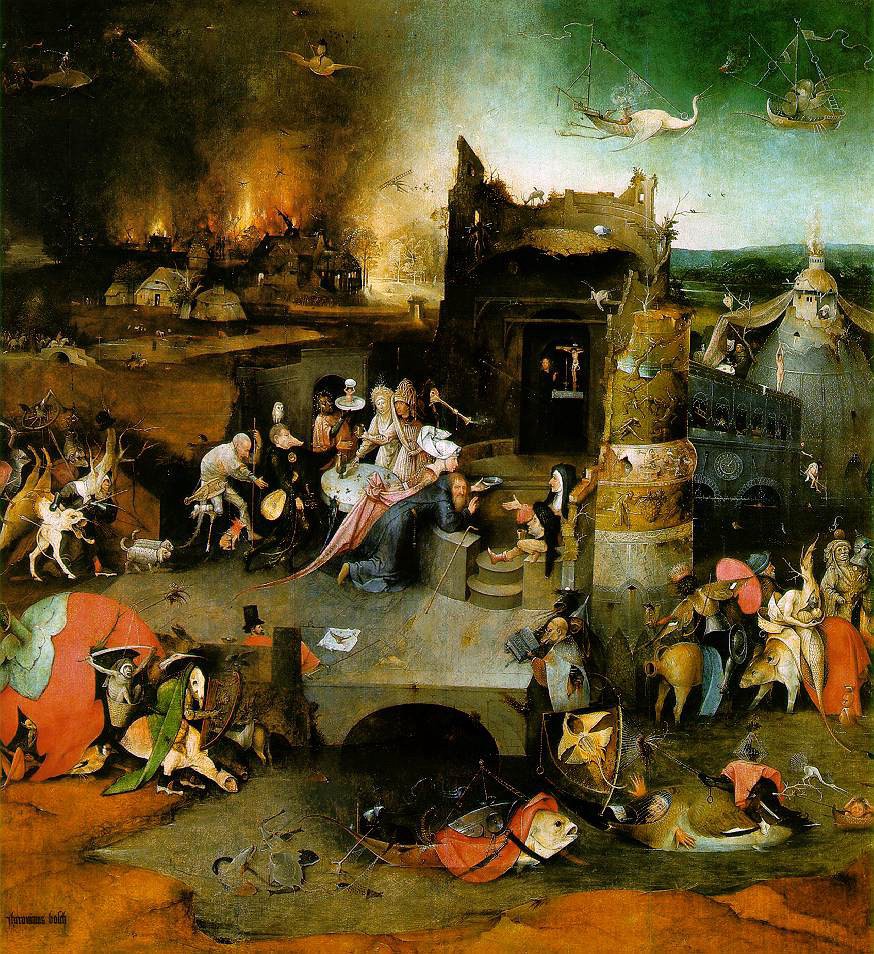 Central Panel: The Temptation of St. Anthony.
Central Panel: The Temptation of St. Anthony.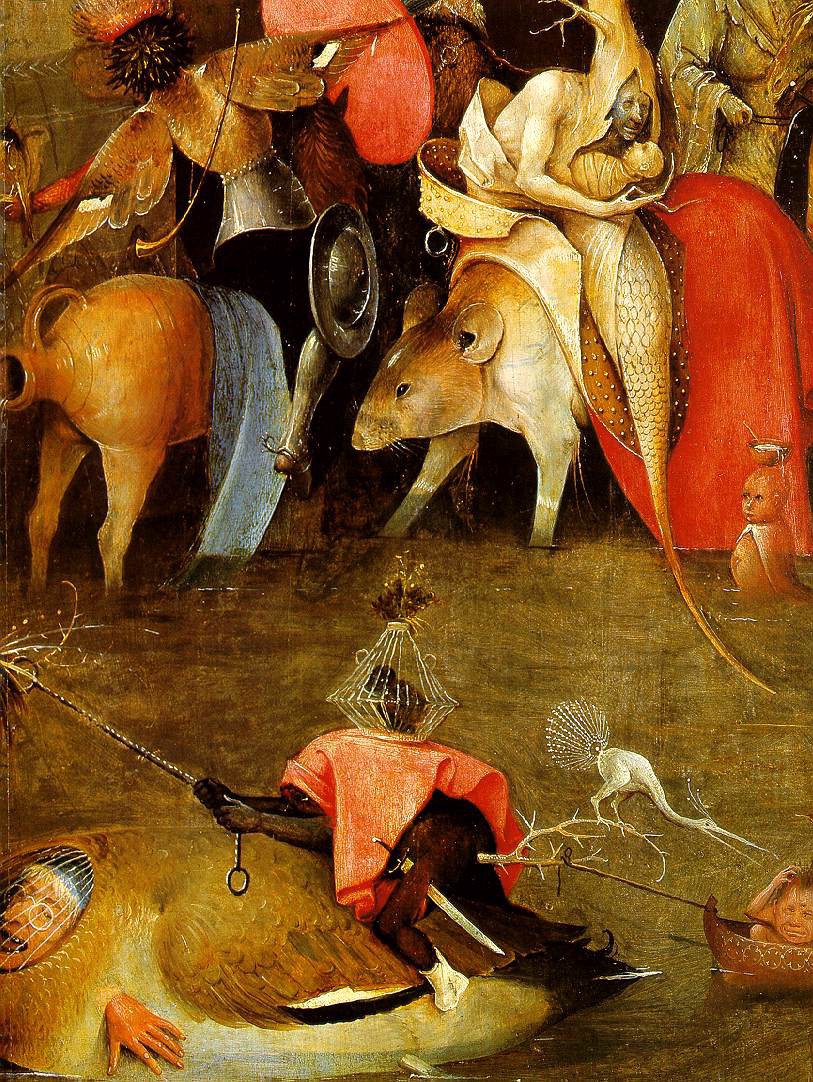 The Temptation of St. Anthony Central Panel: Detailed View.
The Temptation of St. Anthony Central Panel: Detailed View.
The Temptation of Saint Anthony is a triptych painted circa 1500 using oil paint on oak. It?s central panel measures 131.5 centimeters by 119 centimeters, its side panels measure 131.5 centimeters by 53 centimeters. The closed triptych displays various temptations assaulting Christ on his trip to Calvary. The open triptych depicts the three stages of Salvation for Saint Anthony, being assaulted, like Christ, by demons and temptations until he finds salvation as a hermit.
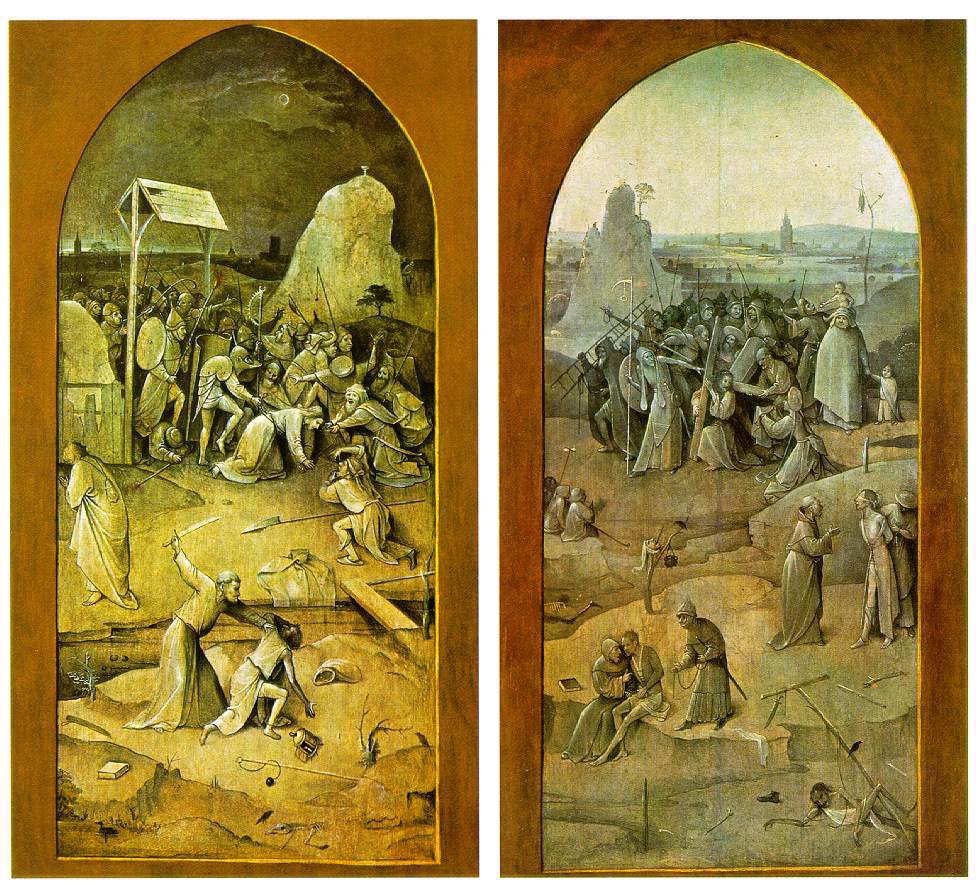 Outer Wings of the Closed triptych: The Temptation of St. Anthony
Outer Wings of the Closed triptych: The Temptation of St. Anthony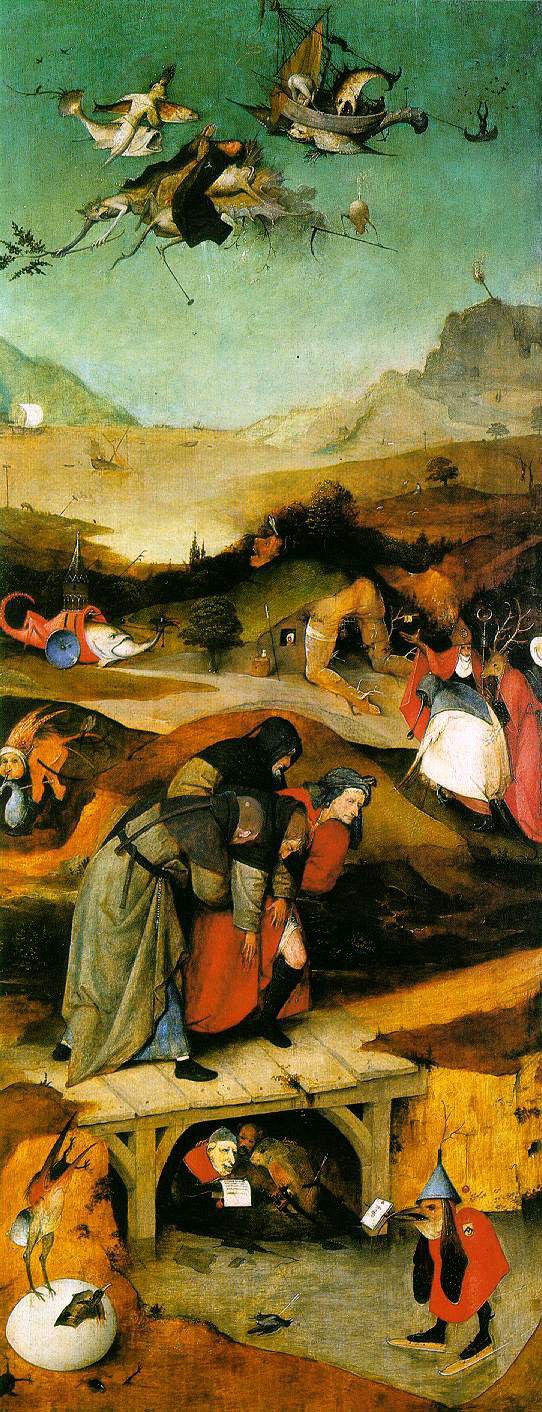
 L ? The Temptation of St. Anthony: Left Wing of the Open Triptych. R ? The Temptation of St. Anthony: Right Wing of the Open Triptych.
L ? The Temptation of St. Anthony: Left Wing of the Open Triptych. R ? The Temptation of St. Anthony: Right Wing of the Open Triptych.
It is in this central panel depicting the temptations and demons assaulting Saint Anthony that we see Bosch as ?demon maker? in full sway and the archetype of hell breaking through. A multitude of monsters and blasphemous scenes, like a black mass being performed (toward the panel?s center), are pictured here. One of the more prominent monsters that hits the viewer here is one taken from popular demonology recorded in the Legenda Aurea (or ?Golden Legend?, a early version of The Lives of the Saints) of Saint Anthony. It has been described as ?an old hag, holding an infant in her arms, riding on a beast that is half pig and half hare. Her lower half is a fish-tail, her head-gear a hollow log.? This is, however, a wrongheaded interpretation for two reasons. First, the face is not the face of an old hag or even that of a woman, but that of a man. Second, the beast being ridden by this man is not some bizarre mishmash of species, but merely a gigantic rat.
This revised view of the rat rider holding an infant lends credence to this being an element referencing a much older esoteric and iconographic interpretation adopted by Bosch as a diatribe against the decadent ?Church Triumphant? which indeed is the single most constant theme of medieval heretics and would-be heretics. There exists a very old Babylonian astrological figure called Oannes, who is himself a Christ-like figure. Oannes is preserved in the esoteric zodiac as Ichton who is further linked with the Pisces sign. Pisces or Ichton is usually pictured as a fish-tailed man with a child (or small man) in his hand (as he is credited, like God in the Judeo-Christian tradition, of creating man from clay) and a mason?s ruler in the other. The fish-tailed man is very relatable sign to Christianity which has had the sign of the fish since the earliest days of the Church. The baby or small man is a double-entendre emblematic of both Christ (?the Second Adam?) and the original Adam. This symbol can and should be carried over to Bosch?s painting.
There is, however, another deeper strain of meaning here. There are also references to the swaddling clothes of the Jesus of Luke?s Gospel and to the Virgin Mary holding the child. The ?dead tree head-gear? is referential to all this and also another double-entendre: being both a symbol of the Tree of the Knowledge of Good and Evil, the withered tree that got man booted from Paradise, and attached to the wages of sin, but also emblematic of the ?tree of life? as Christ referred to himself and the Church to him, and also the tree he was hung on to expiate man?s sins. This a very masterfully done satire on the Church Triumphant.
IV. The Garden of Earthly Delights
 Closed Shutters, The Garden of Earthly Delights: Depicting the Third Day of Creation.
Closed Shutters, The Garden of Earthly Delights: Depicting the Third Day of Creation. Central Panel, Ecclesia?s Paradise, The Garden of Earthly Delights.
Central Panel, Ecclesia?s Paradise, The Garden of Earthly Delights.
Our understanding of Bosch is ?decidedly incomplete? however, unless we can attach reasoned philosophical unity to Bosch?s work. This unity has been posited to exist in a variant of the Adamite heresy that existed contemporaneously with Bosch in the form of the Brethren of the Free Spirit. The Adamite heresy and its variants had practices like worshipping naked, the abolition of marriage, sexual intercourse as a prayer to God and the like. They believed they re-attained their innocence and could be as Adam and Eve in the Garden. It has been hypothesized that The Garden of Earthly Delights is proof that Bosch was either an adherent of the Brethren?s esoteric school or retained by the Brethren to communicate their secrets through secret symbological systems in art.
The Garden of Earthly Delights is a triptych plus shutters painted circa 1504 with oil on oak panels. Its central panel (Ecclesia?s Paradise) measures 220 centimeters by 195 centimeters. The shutters on the outer wings depict the Creation of the World (the third day of the biblical account of creation) and measure 220 centimeters by 97 centimeters. The left wing is The Earthly Paradise (or The Garden of Eden) and the right wing is Hell.
Enjoy this site which offers visitors the ability to wander through the triptych digitally.

 L ? Left Wing of the Open Triptych: The Garden of Earthly Delights, Depicting the Garden of Eden. R ? Right Wing of the Open Triptych, The Garden of Earthly Delights: A Vision of Hell.
L ? Left Wing of the Open Triptych: The Garden of Earthly Delights, Depicting the Garden of Eden. R ? Right Wing of the Open Triptych, The Garden of Earthly Delights: A Vision of Hell.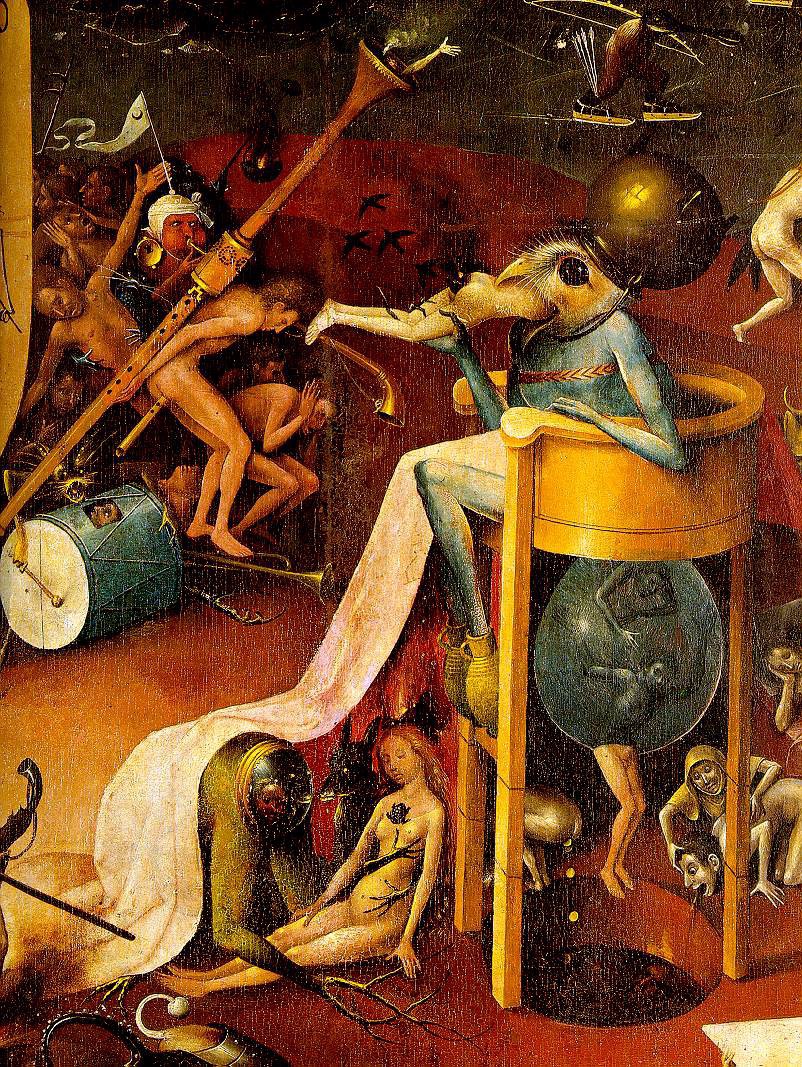 Detail from the Vision of Hell, Right panel.
Detail from the Vision of Hell, Right panel.
The Garden of Eden left wing is where the Adamite inquiry will be focused. We see a three plane vertical division on this panel. Eve being presented to Adam by Christ in the Garden is the lowest plane, the middle plane is comprised of a large fountain in the center surrounded by many exotic animals like giraffes, the top plane is very populated with solar and lunar symbolism and some rock outcroppings with a hidden meaning.
It should be first observed here that the implication of Christ creating the world (as evidenced by him presenting Eve to Adam) is heretical in and of itself. This, however, is likely not Bosch?s intended meaning because the scene is very sexual in the first sense of the positioning of the couples? bodies. Adam is posed concave (sitting on the ground) to Eve?s partially standing convex form, suggestive of a sexual position. This leads to the Adamite idea that this scene merely means through sex we can unite with Christ.
There is further sexual imagery in the piece as well that can only be seen and examined through a look at the secret geometry of the piece. The fountain in the second plane of The Garden of Earthly Delights has a hole in its middle that historians and occultists have viewed as a fulcrum through which diagonal vertical lines can be drawn from the couples? respective sexual parts (see this in the graphic below) on the bottom plane and terminating on the top most solar (or symbolically masculine plane) and lunar (or symbolically feminine plane) for Adam and Eve respectively. Furthermore, the Eve line has a womb shaped spindle of swallows surrounding it as well. ?Medieval bestiaries taught that the swallow hibernated in mud during the winter, and its advent in the spring was looked upon as a rebirth from the death state of winter.?
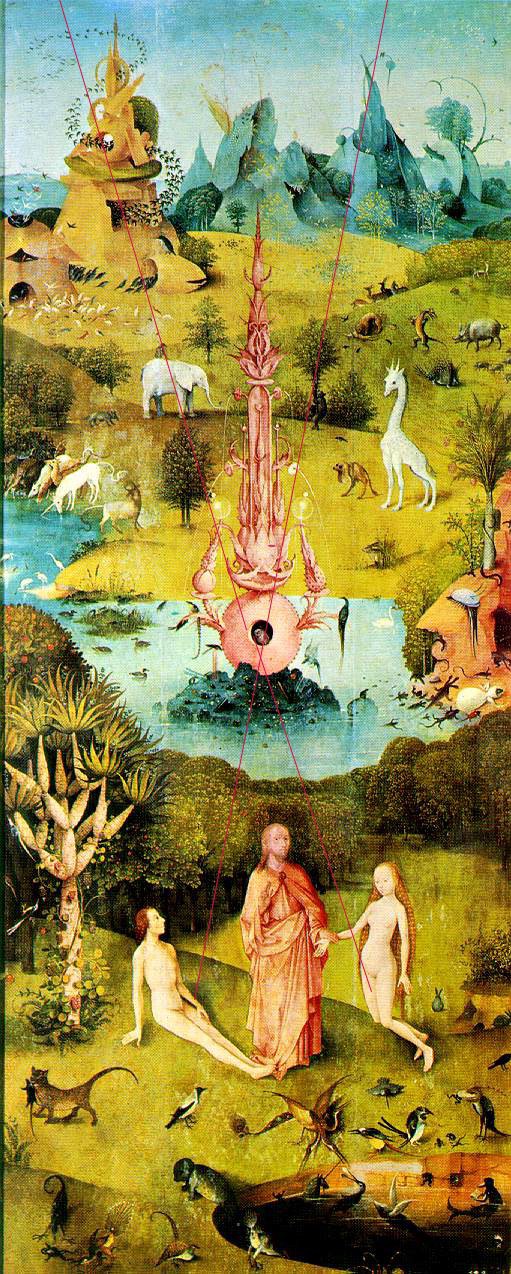 Left wing of the triptych with the imaginary line drawn to show the sacred geometry.
Left wing of the triptych with the imaginary line drawn to show the sacred geometry.
There is notable sexual symbolism in the terminal point of the Adam line as well that goes beyond a simple interpretation of the rock as a phallic symbol (which is certainly can be viewed as). There is a ball and spindle (itself also phallic like) hanging from the rock. This phallus interpretation is not enough though, because the fact is, the ball and spindle is a very common Dutch alchemical sigil for the sun. Thus, this symbol is connected to Adam (in its sexual component) and Christ (in its solar component). The fulcrum also suggests the idea that (in the sexual and symbolic state) the lunar qualities (painted in cool blue colors) are shared by the solar and the solar qualities (painted in warm colors) are shared by the lunar. This a very Adamite idea and theme, the lunar being necessary for the solar and vice versa, and also something quite integral to the alchemical marriage or union of opposites in both alchemy and in an individual as described and noted in Jung?s analytical psychology.
There is a further occult link here between Adam and Christ as a ?Piscean device.? The imagery here is a gesture reminiscent of Pisces or Ichton as Adam?s foot is over the foot of Christ. There is still another level of astrological symbolism in this piece, namely an allusion to another water sign: Cancer. The fountain has been called ?cancroid in shape and colour? and ?resembles the shell of a crab standing upright, crowned with a half-moon with the pincers raised.? This may be a bit of a leap of analysis but ?there is no doubt that certain elements within its construction are cancroid: the colour is that of a boiled crab, whilst the articulation of forms, and many of the textures remind one of the crab?s shell.? The top of the fountain is crowned with a crescent moon structure which further confirms this Cancer connection, as the water sign is many astrological systems is ruled by the moon. This link is lastly non-accidental. There were many Themae Mundi (or Horoscopes for the Creation of the World) in common circulation in Bosch?s day. Most of these (including the ancient Babylonian one) hold to the belief that Cancer was on the Ascendant (that is, on the Eastern horizon) during the creation of the world.
Bibliography (a few sources not linked in)
?Follower of Hieronymus Bosch | Christ?s Descent into Hell | The Met.? The Metropolitan Museum of Art, I.e. The Met Museum. Accessed April 11, 2016. http://www.metmuseum.org/art/collection/search/435725.
Gettings, Fred. The Occult in Art. New York: Rizzoli, 1979.
?Hieronymus Bosch, Garden of Earthly Delights.? Choice Reviews Online 40, no. 04 (2002). doi:10.5860/choice.40?1961.
?Bosch, Hieronymus: The Garden of Earthly Delight.? WebMuseum:. Accessed April 11, 2016. https://www.ibiblio.org/wm/paint/auth/bosch/delight/
Fraenger, Wilhelm, Helen Sebba, and Patrik Reutersward. Hieronymus Bosch. Basel: G B Arts International, 1994.
Jung, C. G., and Marie-Louise Von Franz. Man and His Symbols. New York: Dell Pub., 1968.
Freud, Sigmund, and James Strachey. The Interpretation of Dreams. New York: Basic Books A Member of the Perseus Books Group, 2010.
Freud, Sigmund, and James Strachey. Introductry Lectures on Psychoanalysis. New York: Norton, 1977.
?I Am Surrealism: Salvador Dal ? Baterbys Art Gallery.? Baterbys Art Gallery. Accessed April 11, 2016. http://www.baterbys.com/i-am-surrealism-salvador-dali/.
?Hieronymus Bosch, The First Surrealist.? Hieronymus Bosch, The First Surrealist. Accessed April 11, 2016. http://www.anthonychristian.co.uk/ezine16.html.
?The Adamites: Hippy Heretics of the Middle Ages ? Medievalists.net.? Medievalistsnet. 2014. Accessed April, 11 2016. http://www.medievalists.net/2014/08/10/adamites-hippy-heretics-middle-ages/.
?The Heresy of the Free Spirit.? The Heresy of the Free Spirit. Accessed April 11, 2016. https://www.dhushara.com/book/consum/free.htm.
Oedipus Aegyptiacus Vol 3 Ed 1652 1654. S.l.: Hachette Livre-Bnf, 2012.
Lundy, John P. Monumental Christianity or The Art and Symbolism of the Primitive Church: As Witnesses and Teachers of the One Catholic Faith and Practice. Whitefish, MT: Kessinger Publishing, 2003.
Giorgi, Rosa, and Stefano Zuffi. Saints in Art. Los Angeles: J. Paul Getty Museum, 2003.
Murray, Peter, and Linda Murray. The Oxford Companion to Christian Art and Architecture. Oxford: New York, 1996.
Read, John. Prelude to Chemistry: An Outline of Alchemy, its Literature and Relationships. The MacMillian Company, 1937.
Thomson, Sandra A. Pictures from the Heart: A Tarot Dictionary. New York: St. Martin?s Press, 2003.
Roach, Marilynne K. The Salem Witch Trials: A Day-by-day Chronicle of a Community under Siege. New York: Cooper Square Press, 2002.
Bourke, Joanna. Fear: A Cultural History. Emeryville, CA: Shoemaker Hoard, 2006.
McGinn, Bernard. The Essential Writings of Christian Mysticism. New York: Modern Library, 2006.
Catechism of the Catholic Church. Liguori, MO: Liguori Publications, 1994.
Wess A. Haubrich is the contributing editor of the film section of The Nu Romantics and London?s award-winning culture website The 405. He is also a ?top writer? in ?movies?, ?mental health? and ?culture? on Medium.com. He can be reached on Twitter or via email: [email protected] as he is always looking for cutting edge undiscovered cinema especially and innovative forms of all kinds of art to bring to his readers by probing the minds of their creators in interviews and features.
